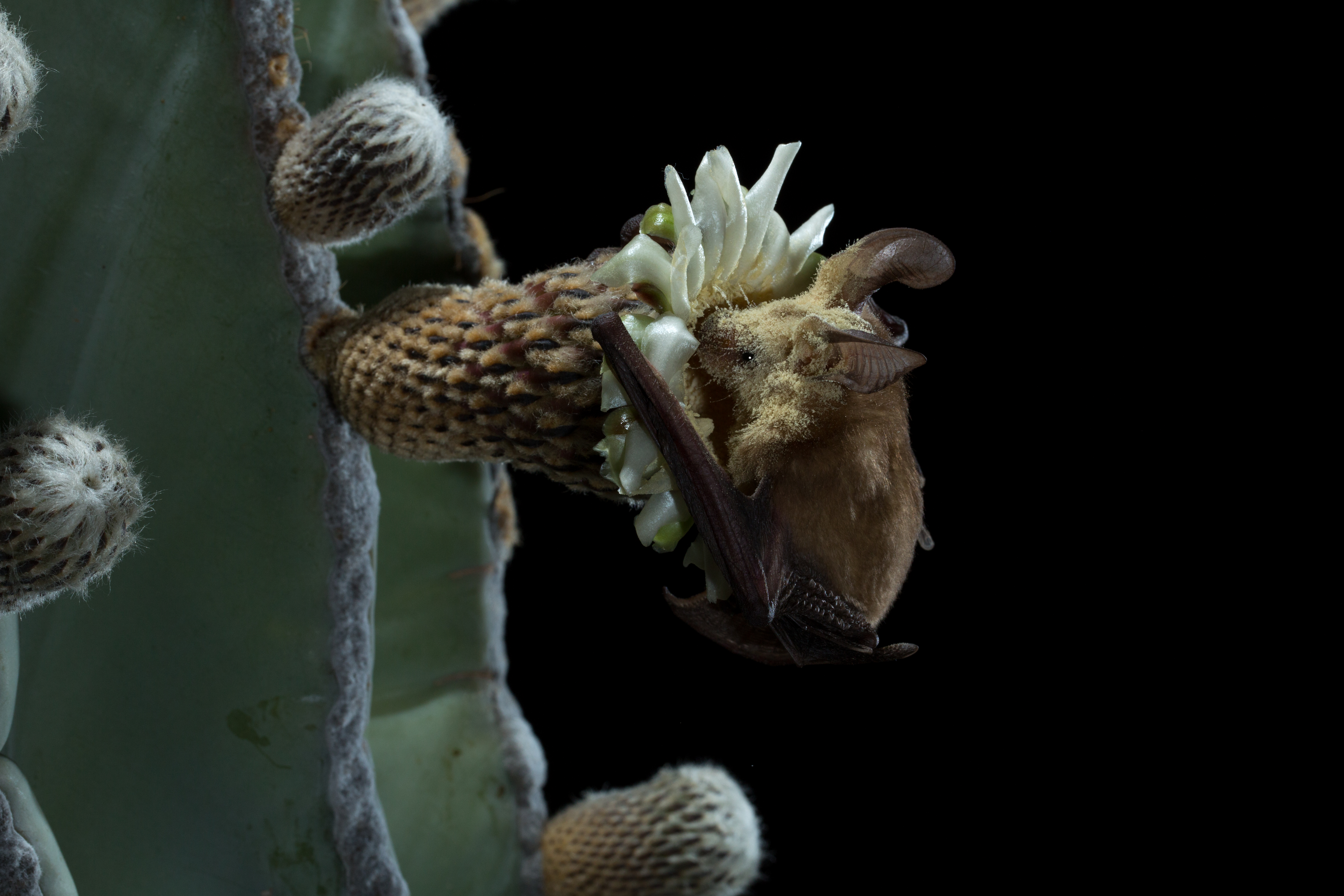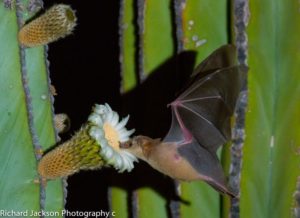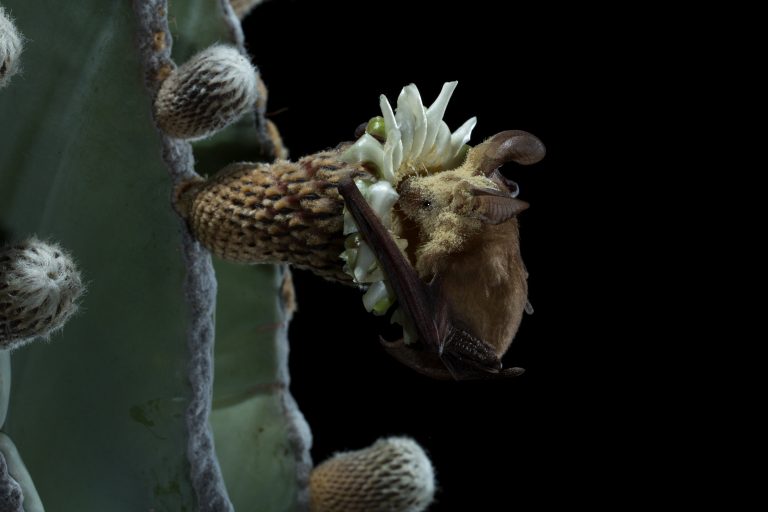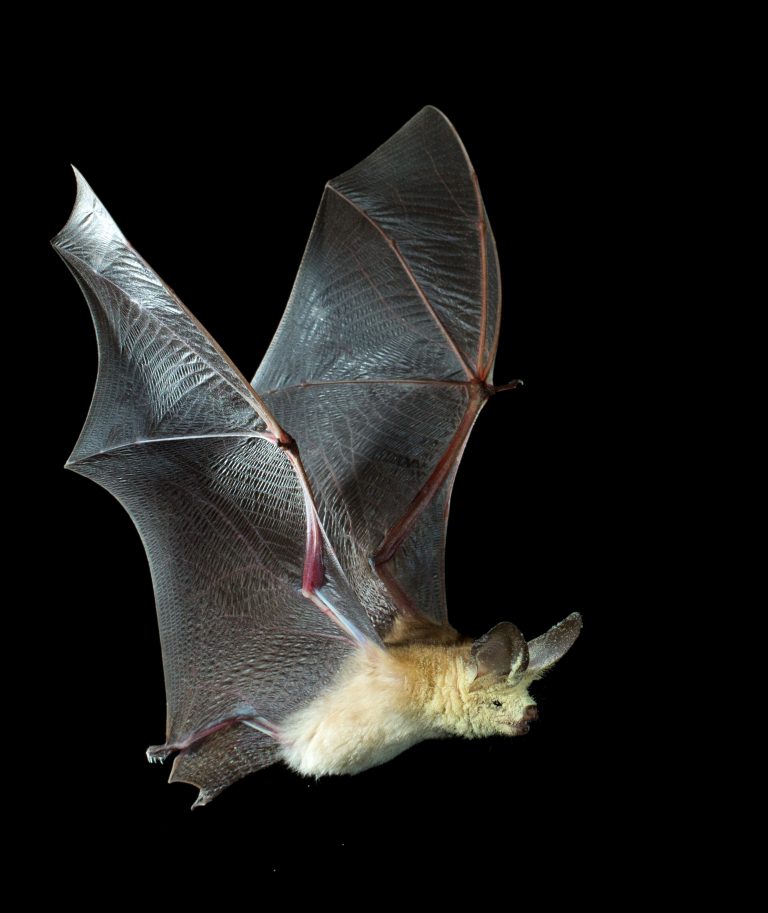
Battle of the Baja Bats
by Bryan Batson Jáuregui, Todos Santos Eco Adventures
This article first appeared in Janice Kinne’s Journal del Pacifico.
The cardón cactus, endemic to Baja California, is one of the most massive and ubiquitous cacti on the planet. Huge groves of multi-limbed old timers that witnessed the arrival of the first Europeans over five centuries ago can still be seen the length of the peninsula, and single young upstarts that haven’t even sent up their first arm yet crowd the desert landscape. What accounts for such rampant success? In a word, bats. Now of course there are many factors that help the cardón survive – isolation, summer rains, water retaining skeletons – but none of this would matter if it wasn’t for the bat, because the cardón is a cactus that deigns to open its flowers for pollination only as the sun is setting, a time when the kings of the PM pollination scene are emerging from their caves ravenous for their first meal of the night. That’s right, bats.
But not just any bat. Researchers have known for years about the role of the lesser long-nosed bat (Leptonycteris yerbabuenae) in cardon pollination. In fact, when a young graduate student named Winifred Frick arrived in Baja in 2004 to work on her dissertation in bat ecology, the lesser long-nosed bat was considered the only cardón pollinator game in town. Says Frick, “The lesser long-nosed bat is highly specialized for nectar-feeding. It can hover at an open cardón flower and use its

Lesser long-nosed bat. Photo by Rick Jackson.
long tongue to extract nectar, transferring pollen from one flower to the next in the process.” Clean, precise, targeted. Evolution at its most elegant. “So I was really surprised to see this other desert bat, the pallid bat (Antrozous pallidus), regularly visiting cardón flowers. The pallid bat has a short face, long ears and loves to eat scorpions off the ground. At first I thought maybe it was visiting the bat-adapted flowers of the cardon to opportunistically glean insects attracted to the flowers. But as we observed it over 2005-2007, we realized that the pallid bat was actually indulging in cardón flower nectar. Apparently it likes a little something sweet to wash down savory scorpion meals. However, unlike the lesser long-nosed bat, the pallid bat doesn’t hover but dives onto the whole flower, caking its whole body in pollen.” A cardón pollinator usurper?
Frick, now Dr. Frick of the Department of Ecology and Evolutionary Biology at the University of California, Santa Cruz, was doing her dissertation on “the relationship between the size and isolation of (Baja) islands and bat species richness in a near-shore archipelago …” so didn’t follow up on her pallid bat observations at the time. But she didn’t forget the pollen-laden pallids, and a few years later teamed up with some of her UC Santa Cruz colleagues to study bats and cardón pollination in more depth, resulting in game-changing research that was published in American Naturalist in 2012 (Frick is the lead author of the study conducted with her colleagues Ryan Price, Paul Heady and Kathleen Kay). For the study, which was funded in part by the National Geographic Society and UC MEXUS, Frick and her team monitored cardón flowers at several sites in southern Baja. When they saw a bat visit a flower they would identify which of the two cardón-nectar-loving rivals it was, then retrieve the stigma of the flower to determine how many grains of pollen the bat had deposited. They also recorded the total number of flower visits by each of the two species at each study site. Turns out, pollination’s not just for the long-nosed crowd.

Pallid Bat on Cardon Flower. Photo by Merlin Tuttle. http://merlintuttle.org
“The results blew us away. The lesser long-nosed bat has an ancient cardón-pollinating lineage that has been co-evolving with the cardón flower for a very long time. We were therefore very surprised to see that the newby, the pallid bat, is a far more effective pollinator, delivering about 8 times as much pollen per visit. We observed several factors that account for this. One is that the pallid bat rests its body on the flower and plunges its whole head into the flower to get at the nectar. It therefore gets far more pollen on its body than the hovering lesser long-nosed bat, who is using its tongue only to access nectar. So this new pollinator is actually better than the more specialized pollinator because it is not well-adapted to nectar feeding. (The pallid is the only nectar feeder from an insect-feeding family, Vespertilionidae). Its stats are also helped by the fact that the lesser long-nosed bat uses pollen as a source of protein, so therefore regularly eats the pollen off its fur, reducing the amount available for pollination. Finally, the lesser long-nosed bat is migratory while the pallid bat is a year-round Baja resident, a fact that makes the pallid bat especially important to the cardón.”
The cardón. Amazing record of longevity and survival. How has it done that? It has been scientifically shown that plants respond to stimuli such as sound and touch. Some wounded plants produce a chemical that acts as an alarm signal, prompting nearby plants to produce chemicals that help them defend themselves against insects – or attract insect predators. Venus fly traps just eat the interlopers. So is it possible that the cardón has sensed that it’s a hair risky to continue entrusting its future solely to an endangered, migratory, picky eater like the lesser long-nosed bat? Has it therefore made its flower scent / nectar taste so enticing that even – or perhaps especially – a scorpion-loving, insect-grubbing, and – until recently – flower-snubbing permanent Baja resident like the pallid bat would literally plunge in head first to its rescue? Says Frick’s co-author Kathleen Kay, “What is actually happening in terms of how species are mutually interacting can be more complicated than what meets the eye.” Wily cardón. Lucky bats.

Pallid bat photo by Merlin Tuttle. http://merlintuttle.org
Photographer Merlin Tuttle
Merlin Tuttle decided to devote the remainder of his career to bat conservation in 1982 “as an act of desperation. It was obvious that without major improvement in public attitudes, the situation for bats would continue to worsen.” Battered by centuries of harmful myths and misinformation, bats were despised and casually slaughtered around the world. Merlin has made education – correcting those myths and teaching the economic and ecosystem benefits of bats – a major part of his work. Distressed that most bat photographs showed roughly handled bats snarling in self-defense,Merlin taught himself photography. He became a world-class wildlife photographer whose images have appeared in books and magazines around the world and played a crucial part in his education efforts. To view his amazing photographs and contribute to his bat conservation efforts, please visit http://merlintuttle.org/.
© Copyright Sergio and Bryan Jauregui, Casa Payaso S de RL de CV, 2015
